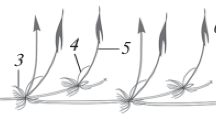Summary and Conclusions
The root apical organization of seven species belonging to six genera of the family Palmeæ has been investigated and reported.
The structural organization in these species falls under three types, one with a common group of initials for all the histogens, the second where the initials are common for the dermatogen and calyptrogen while the rest arise from a common group at the centre, and a third, where there are independent initials for plerome and root-cap and a common tier for the dermatogen and periblem.
On the basis of this, a tentative suggestion is made regarding the evolutionary trend of the root apical organization in these.
The cell complexes are analysed.
The meristem concerned with the formation of the two parts of the calyptra is distinguished into two zones, the peripheral region outside and the columellogen in the centre, on the basis of the types of cell division.
The endodermis is traced in its origin to an endodermis-periblem complex.
The cyto-physiological state of the cells at the root apices when studied showed that a quiescent centre is present at the extreme tip of the root body. This is surrounded on the side of the root body by a group of cells which appear to be the real site of histogenetic activity, named the meristematic zone.
The inadequacy of limiting the study of root apices to the structural configuration alone, and of combining it with other aspects like the cytophysiological state of the cells, is once again exemplified.
Similar content being viewed by others
References
Allen, G. S... “Embryogeny and the development of the apical meristems ofPseudotsuga—III,”Amer. J. Bot., 1947,34, 73–80.
Brumfield, R. T... “Cell lineage studies in root meristems by means of chromosome rearrangements induced by X-rays,” Ibid., 1943,30, 101–110.
Clowes, F. A. L... “Root apical meristems ofFagus sylvatica,”New Phytol., 1950,49, 248–67.
—————.. “Localization of nucleic acid synthesis in root meristems,”J. exp. Bot., 1956a,7, 307–12.
—————.. Nucleic acids in root meristems ofZea,”New Phytol., 1956b,55, 29–34.
—————.. “Development of quiescent centres in root meristems,” Ibid., 1958a,57, 85–87.
----- .. “Reorganization of root apices after irradiation,”Ann. Bot Lond., N.S.,23, 205–10.
Davidson, D... “Meristem initial cells in irradiated roots ofVicia faba,” Ibid., 1960,24, 287–95.
*Eriksson, J... “Über das Urmeristem der Dikotylen-Wurzeln,”Jb. Wiss. Bot., 1878,11, 380–436.
Esau, K. ..Plant Anatomy, 1953, New York.
Guttenberg, H. von .. “Der primäre Bau der Angiospermenwurzel,” Linsbauer’sHandbuch der Pflanzenanatomie, 1940, Berlin.
----- .. “Der Primäre Bau der Gymnospermenzurzel,”Ibid., 1941, Berlin.
----- .. “Grundzüge der Histogenese höherer Pflanzen. I. Die Angiospermen,”Ibid., 1960, Berlin.
Haberlandt, G. ..Physiological Plant Anatomy, 1914, London.
Hayward, H. E. ..The Structure of Economic Plants, 1938, New York.
*Janczewski, E. De.. “Recherches sur l’accroissement terminal des racines dans les phanerogames,”Ann. Sci. nat. bot., 1874, Ser. V,20, 162–201.
Jensen, W. A... “The incorporation of C14-adenine and C14-phenylalanine by developing root-tip cells,”Proc. nat. Acad.Sci., U.S.. 1957,43, 1039–46.
Jensen, W. A... “The nucleic acid and protein content of root-tip cells ofVicia faba andAllium cepa,”Exp. Cell Res., 1958,14, 575–83.
Pillai, S. K. and Pillai, A. .. “Root apical organization in Monocotyledons—Musaceæ,J. Indian bot. Soc., 1961a (In press).
----- .. “Root apical organization in Monocotyledons—Cannaceæ,”Ibid., 1961b (In press).
—————.. “Root apical organization in Monocotyledons—Marantaceæ,”Proc. Indian Acad. Sci., 1961c,53 B, 302–17.
----- .. “Reactions of root apices to some surgical experiments,”J. Indian bot. Soc., 1961d (In press).
—— and Sachdeva, S... “Effect of some surgical excisions on the regeneration of the root apex ofSorghum vulgare Pers.,”Curr. Sci., 1960,29, 232–34.
--, Pillai, A. and Girijamma, P. “Root apical organization in Dioctyledons—I,”Proc. Raj. Acad. Sci., 1961 (In press).
—— and Sachdeva, S... “Root apical organization in Monocotyledons—Zingiberaceæ,”Proc. Indian Acad. Sci., 1961,53 B, 240–56.
Popham, R. A. ..Developmental Plant Anatomy, Columbus, Ohio, 1952.
Schüepp, O... “Untersuchungen über Wachstum und Formwechsel von Vegetationspunkten,”Jb. wiss. Bot., 1917,57, 17–79.
*Treub, M. ..Le Meristeme Primitif de la racine dans les Monocotyledones, E. J. Brill, Leiden, 1876 (quoted by Popham, 1952).
Author information
Authors and Affiliations
Additional information
Communicated by Prof. T. S. Sadasivan,f.a.sc.
This forms part of this author’s doctoral thesis.
Rights and permissions
About this article
Cite this article
Pillai, S.K., Pillai, A. Root apical organization in monocotyledons—Palmeae. Proc. Indian Acad. Sci. 54, 218–233 (1961). https://doi.org/10.1007/BF03051050
Received:
Issue Date:
DOI: https://doi.org/10.1007/BF03051050




